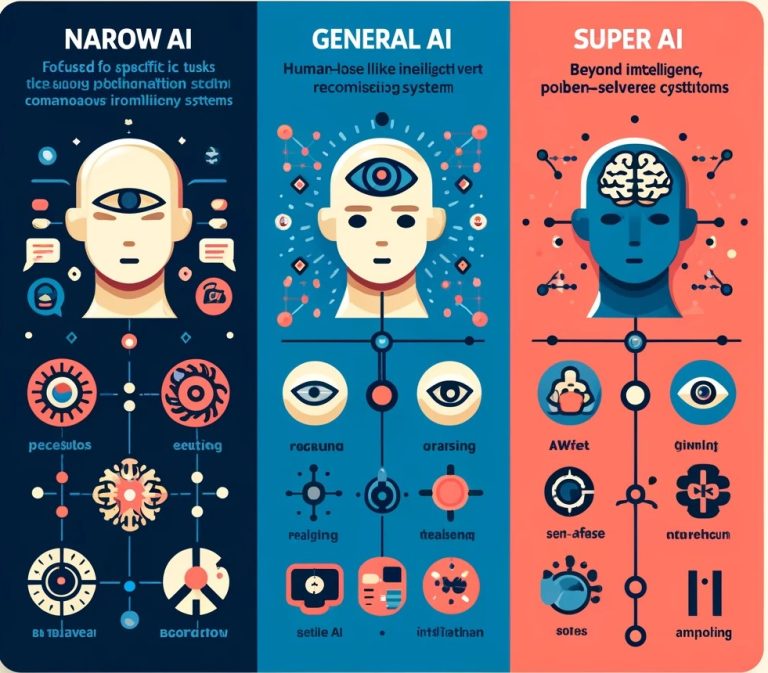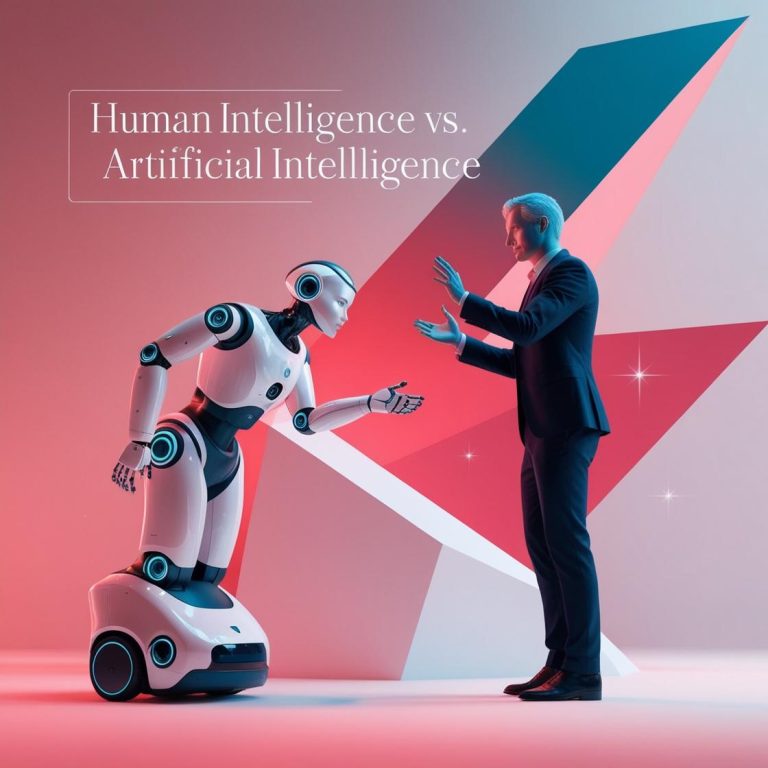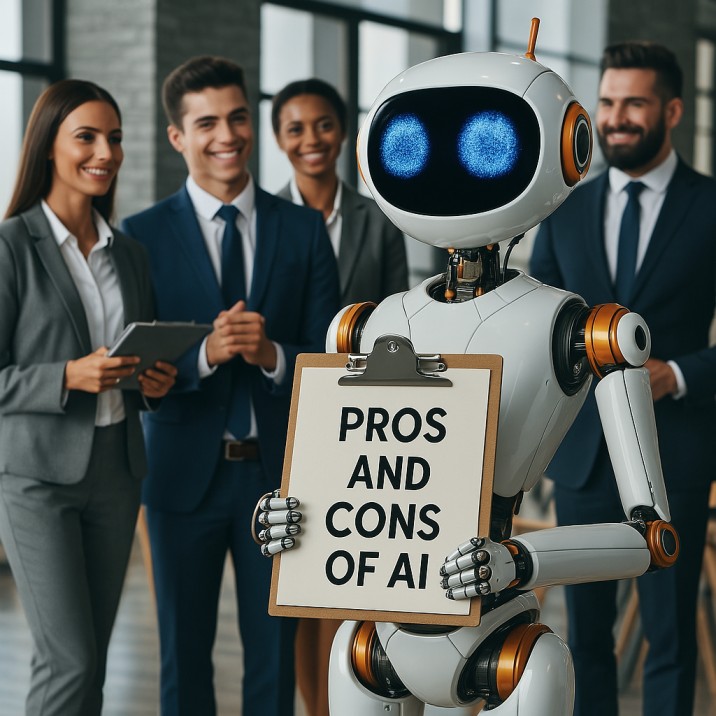The Types of AI: A Simple Guide for Everyone
Artificial Intelligence (AI) is revolutionizing the world, from virtual assistants like Siri and Alexa to self-driving cars and advanced healthcare diagnostics. However, AI isn’t just one kind—there are different types of AI with unique abilities! Some AI systems help us in our daily lives, while others are still in development or exist only in theories.
In this blog, we’ll explore the different types of AI, their benefits, challenges, and the impact they may have on the future.

What is AI? 🤖
AI, or Artificial Intelligence, is when machines can think, learn, and make decisions like humans. AI is already helping in many ways, such as:
- Recognizing faces and unlocking phones (Face ID)
- Suggesting movies, music, and products (Netflix, YouTube, Amazon)
- Assisting in medical diagnosis (AI in healthcare)
- Driving cars without human control (Tesla, Waymo)
But not all Types of AI is the same—some AI is simple and designed for specific tasks, while others aim to think like humans. Let’s explore the different types.
Types of AI Based on Intelligence 🧠
AI can be divided into three categories based on its level of intelligence.
1. Weak AI (Narrow AI) 🛠️
Definition:
Weak AI, also known as Narrow AI, is an artificial intelligence system that is designed to perform a specific task. It operates under pre-defined rules and cannot think or make decisions beyond its programming. It does not possess general intelligence or self-awareness.
Key Features:
- Specializes in one task
- Cannot learn beyond its training
- Relies on human programming and data
- Most AI we use today falls under this category
Examples of Weak AI in Daily Life:
- Voice Assistants – Siri, Alexa, and Google Assistant can answer questions and perform tasks but cannot think for themselves.
- Recommendation Systems – Netflix, YouTube, and Amazon suggest content based on your past choices, but they cannot understand emotions or intent.
- Facial Recognition – AI-powered security cameras detect faces but do not understand who the person is beyond data matching.
- Chatbots – AI customer support chatbots can respond to inquiries but cannot engage in real, deep conversations like a human.
💡 Fun Fact: A chess-playing AI like Deep Blue, which defeated world chess champion Garry Kasparov in 1997, is a Weak AI. It can play chess at a superhuman level but cannot do anything else.
2. Strong AI (General AI) 🧠
Definition:
Strong AI, also called General AI, is an AI system that can think, reason, learn, and apply intelligence across different tasks—just like a human. It can understand emotions, solve problems, and make decisions independently.
Key Features:
- Thinks and learns like a human
- Adapts to new situations without human intervention
- Can perform multiple different tasks, not just one
- Still in development—not yet achieved
Potential Future Examples of Strong AI:
- AI Doctors – AI diagnosing diseases and making medical decisions as effectively as human doctors.
- AI Scientists – AI conducting research, making discoveries, and inventing new technologies.
- AI Teachers – AI understanding each student’s learning style and teaching accordingly.
- AI Lawyers – AI analyzing legal cases and offering expert legal advice.
💡 Why is General AI Difficult to Achieve?
Creating true human-like intelligence requires AI to:
- Learn from any experience, like a child
- Understand emotions and context
- Apply knowledge from one task to another
- Think creatively and solve new problems
So far, no AI has fully reached this level, but companies like Google DeepMind, OpenAI, and Tesla are working on it.
3. Super AI 🚀 (Artificial Superintelligence)
Definition:
Super AI, also known as Artificial Superintelligence (ASI), is an AI that is more intelligent than humans in every possible way. It can think, reason, create, and make decisions better and faster than any human.
Key Features:
- Self-aware and independent
- Smarter than the best human minds
- Can outperform humans in all fields—science, creativity, emotions, and decision-making
- Only exists in theory and science fiction—NOT developed yet
Examples in Science Fiction:
- The Terminator – AI taking control over the world.
- Avengers: Age of Ultron – An AI becoming too powerful and turning against humans.
- Her – AI that develops real emotions and relationships with humans.
Potential Future Impact of Super AI:
- Revolutionizing Science & Medicine – AI finding cures for deadly diseases instantly.
- Solving Global Issues – AI solving climate change, poverty, and political conflicts.
- Unlimited Creativity – AI writing books, painting, composing music better than any human.
- Possible Risks – AI surpassing human control, becoming unpredictable, or replacing human jobs.
💡 Is Super AI Possible?
Scientists don’t know if Super AI will ever exist. Some believe it could take 50-100 years (or never happen), while others warn that it could be dangerous if not controlled properly.
Types of AI Based on How They Work ⚙️
AI is also classified based on how it functions and learns.
1. Reactive AI
- AI that only reacts based on set rules. It does not learn from past experiences.
Example: Chess-playing AI like Deep Blue, which defeated chess champion Garry Kasparov.
2. Limited Memory AI
- AI that can learn from past experiences and improve over time.
Example: Self-driving cars that learn from past road conditions.
3. Theory of Mind AI
- AI that understands emotions and social interactions (still in research).
Example: Future AI robots that can interact with humans naturally.
4. Self-Aware AI
- AI that can think for itself and have emotions (only a theory for now).
Example: AI in movies like Her or Ex Machina.
Pros and Cons of AI ⚖️
While AI brings many benefits, it also comes with challenges and risks.
✅ Pros of AI:
- Increases efficiency – AI automates repetitive tasks, saving time and effort.
- Reduces human error – AI can analyze large amounts of data with high accuracy.
- Enhances convenience – AI-powered virtual assistants make daily tasks easier.
- Improves healthcare – AI helps in diagnosing diseases faster and more accurately.
- Boosts innovation – AI is used in research, robotics, and new technology development.
❌ Cons of AI:
- Job loss – Automation may replace many human jobs.
- Lack of human emotions – AI cannot truly understand human emotions and creativity.
- Privacy concerns – AI systems collect and analyze large amounts of personal data.
- Risk of AI control – Advanced AI could become difficult to control if not managed properly.
- High cost – Developing and maintaining AI technology is expensive.
Real-Life Uses of AI 🌍
AI is already part of many industries:
- Healthcare – AI detects diseases, assists in surgeries, and analyzes medical data.
- Finance – AI helps banks detect fraud and manage investments.
- Education – AI-powered tutors adapt to students’ learning needs.
- Entertainment – AI writes music, scripts, and even creates digital art.
- Customer Service – AI chatbots handle customer queries instantly.
AI is improving the way we live, but ethical concerns about its impact remain.
The Future of AI 🚀
AI is evolving rapidly, and in the future, we might see:
- AI-powered personal robots that help with daily tasks.
- AI doctors that provide faster, more accurate medical diagnoses.
- Smart cities with AI managing traffic, energy, and security.
- AI becoming more creative, writing books, designing fashion, and composing music.
However, with rapid AI advancements, we must ensure ethical AI development and responsible usage to avoid risks.
Final Thoughts 🎯
AI is already shaping our world, and it will only grow more advanced. From simple chatbots to future self-aware robots, AI is revolutionizing industries, making life easier, and opening doors to incredible possibilities.
However, with great power comes great responsibility. We must ensure AI is used ethically, fairly, and responsibly to benefit society while minimizing risks.
So, what do you think about AI? Are you excited or concerned about its future? Share your thoughts in the comments! 😊




